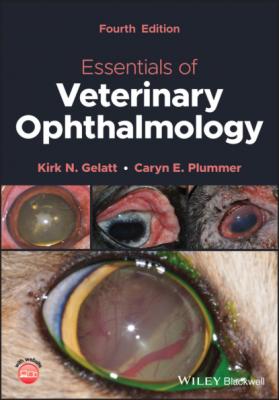Essentials of Veterinary Ophthalmology. Kirk N. Gelatt
Чтение книги онлайн.
Читать онлайн книгу Essentials of Veterinary Ophthalmology - Kirk N. Gelatt страница 26
 Optic cup and lens placode
10
Separation of lens vesicle from surface ectoderm
10
Primary lens fibers
15
Lens vesicle cavity disappears
24
Completion of lens capsule
50
Secondary lens fibers
58
Perilenticular vascular mesoderm
Extension of primary vitreous (hyaloid artery) to lens
15
TVL
33
Disappearance of posterior lenticular vascular network
410
Disappearance of TVL
410
Iris
Major arterial circle of iris
90
Iris reaches front of lens
200
Pigment in stroma
200
Sphincter muscle
410
Dilator muscle
410
Ciliary body
Ciliary processes
125
Ciliary processes touch lens equator
230
Pars plana (distinct)
200
Pars plana fully developed
410
Choroid
Choroidal net in posterior pole
33
Choroidal net throughout
50
Outermost large choroidal vessels
40
Choriocapillaris
90
Pigmentation of choroid
90
Retina – posterior third
Inner and outer nucleated zones
10
Multilayer outer cup of optic vesicle forms single cells
20
Nerve fiber layer
20
Optic nerve well formed
24
Inner/outer neuroblastic layers
14
Transient layer of Chievitz
14
Inner plexiform layer
180
Retinal vessels
180
Tapetal cells
410
Optic cup and lens placode
10
Separation of lens vesicle from surface ectoderm
10
Primary lens fibers
15
Lens vesicle cavity disappears
24
Completion of lens capsule
50
Secondary lens fibers
58
Perilenticular vascular mesoderm
Extension of primary vitreous (hyaloid artery) to lens
15
TVL
33
Disappearance of posterior lenticular vascular network
410
Disappearance of TVL
410
Iris
Major arterial circle of iris
90
Iris reaches front of lens
200
Pigment in stroma
200
Sphincter muscle
410
Dilator muscle
410
Ciliary body
Ciliary processes
125
Ciliary processes touch lens equator
230
Pars plana (distinct)
200
Pars plana fully developed
410
Choroid
Choroidal net in posterior pole
33
Choroidal net throughout
50
Outermost large choroidal vessels
40
Choriocapillaris
90
Pigmentation of choroid
90
Retina – posterior third
Inner and outer nucleated zones
10
Multilayer outer cup of optic vesicle forms single cells
20
Nerve fiber layer
20
Optic nerve well formed
24
Inner/outer neuroblastic layers
14
Transient layer of Chievitz
14
Inner plexiform layer
180
Retinal vessels
180
Tapetal cells
410
Table 1.3 Embryonic origins of ocular tissues.
| Neural ectoderm | Neural crest |
|---|---|
| Neural retina | Stroma of iris, ciliary body, choroid, and sclera |
| RPE | Ciliary muscles |
| Posterior iris epithelium | Corneal stroma and endothelium |
| Pupillary sphincter and dilator muscle (except in avian species) | Perivascular connective tissue and smooth muscle cells |
| Striated muscles of iris (avian species only) | |
| Bilayered ciliary epithelium | Meninges of optic nerve |
| Orbital cartilage and bone | |
| Connective tissue of the extrinsic ocular muscles | |
| Endothelium of trabecular meshwork | |
| Surface ectoderm | Mesoderm |
| Lens | Extraocular myoblasts |
| Corneal and conjunctival epithelium | Vascular endothelium |
| Lacrimal gland | Schlemm's canal (human) |
| Posterior sclera (?) |
It is important to note that mesenchyme is a general term for any embryonic connective tissue. Mesenchymal cells generally appear stellate and are actively migrating populations with extensive extracellular space. In contrast, the term mesoderm refers specifically to the middle embryonic germ layer. In the eye, mesoderm probably gives rise only to the striated myocytes of the extraocular muscles (EOMs) and vascular endothelium. Most of the craniofacial mesenchymal tissue comes from neural crest cell.
Formation of the Optic Vesicle and Optic Cup
The optic sulci are visible as paired evaginations of the forebrain neural ectoderm on day 13 of gestation in the dog (Figure 1.1). The transformation from optic sulcus to optic vesicle is considered to occur concurrent with the closure of the neural tube (day 15 in the dog).
Figure 1.1 Development of the optic sulci, which are the first sign of eye development. Optic sulci on the inside of the forebrain vesicles consisting of neural ectoderm (shaded cells). The optic